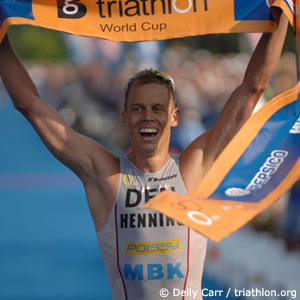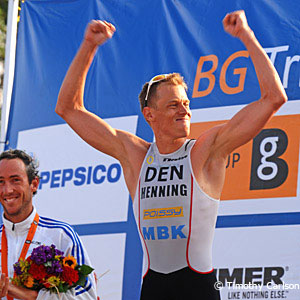Q&A with Rasmus Henning
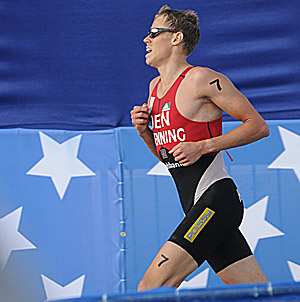
Perhaps no one entering the world of Ironman this year has aroused more interest than Rasmus Henning. The 33-year-old Danish triathlete is a two-time Olympian with superior short course speed and is clutch in many big money events. Henning won the first two $200,000 Hy-Vee men’s titles in 2007 and 2008, a total of five ITU World Cups, the 2006 Saint Anthony’s title, and the 2003 Athens Olympic test event World Cup. A two-time Olympian, he also has a win and a second place at his first two tries at the Ironman distance in 2000 and 2001. This year, he qualified for Kona with a 30-minute margin of victory at Ironman China in Hainan where he was on pace for a world-class 8:15 finish halfway through the run when reported unofficial 114-degree temperatures likely led to severe cramping. Keeping a cool head in record heat, Henning did a good job of crisis management. He walked 4 or 5 miles, finished with a 3:38 marathon, only lost 15 minutes of his 45-minute lead, and won the event in 8:53:20. The question now is did he learn valuable lessons about heat adaptation that will help him contend for the win at Kona? Or did the fade at the end indicate that his at times dominant short course talent might not translate to the lava fields against the toughest field in the sport?
Slowtwitch: How hot was Hainan? I have seen reports that the temperatures were 114 degrees Fahrenheit.
Rasmus Henning: I don’t wear a thermometer in races. But Hainan was very very hot. All I know is that the organizers said it was above 40 degrees Celsius. That’s probably true, but I did not suffer that much. I did get cramps related to the heat but I was not overwhelmed. I never felt the need to stop running and get in the shade with a bucket of ice on my head. I felt pretty strong the whole way, though I did get those cramps because of slight overheating and slight dehydration. From what most people said, it was definitely the hottest race ever done, a lot hotter than Hawaii.
ST: Hotter than the first Hy-Vee where a lot of people were taken to the medical tent?
Rasmus: It was definitely hotter than Hy Vee 2007, but how much I could not tell you. A big difference at Hy-Vee was that I was running at a heart rate of 180 beats per minute, and this race I was at 150. I can cope with heat more easily at 150. You can pay more attention to the cooling process in an Ironman than in a 10k run at the end of a triathlon. In an Ironman, there is more time to cool down at aid stations and take a few seconds to grab a handful of ice and place sponges soaked with cold water under the straps of my singlet.
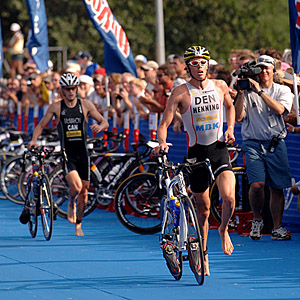
ST: Can you convey the feeling of heat in Hainan?
Rasmus: You can only get an idea of it if you place yourself in a sauna. I’ve not been in that kind of heat in any race. But then again, if I sit in a sauna long enough, I will get to a point where I need to get out and must get cooler air in my lungs and cold water. I did not get to that point – although a lot of other people did.
ST: You seemed to be sailing along to an anticipated 8:15 finish before slowing down to a 3:38 marathon. Did you simply slow down as a precaution because you had a huge lead? Or did you sense that things might have gone long-term wrong if you plunged ahead?
Rasmus: If it had been 10-15 degrees cooler at Hainan, the race would have been very quick. The bike had only slight hills and was potentially very fast. The run was totally flat. No doubt there was a little bit of wind, but it was a blessing on this day.
ST: What set off the cramps?
Rasmus: One big reason is that I did not get my special needs bag halfway through the bike. The bag had three bottles with my own mix of sugar and salt. Missing that did two things. It made me ride 15 to 20k without hydration until I reached the next aid station. That is a long time without drinking anything at all. And when I stopped at the next aid station I drank their Gatorade, which was not the worst mix of sugar and salt, but not precisely formulated for me.
ST: What’s the difference for you?
Rasmus: Gatorade has sugar and electrolytes and salt,. Whereas I had a different mix of drink and I use Salt Stick tablets.
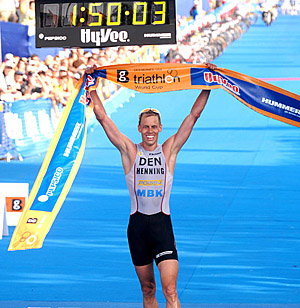
ST: How bad was the cramping?
Rasmus: The cramping ended up being very serious because I came to a point where there was no chance I could run. Old ladies were riding past me and I waved them good luck, good job. It is frustrating to feel like you have enough energy to go fast. But when I lifted my feet up and got impact, my legs cramped up. If one of the guys passed me, there was no way I could have responded.
ST: How did you keep it together to win the race?
Rasmus: I did run pretty quickly to halfway. I came through at 1:30 to 1:32 although the markings were pretty spare. From 25 kilometers to 35, I started running and then walking five steps, then running and walking 30 steps. Then I pretty much walked completely from kilometer 35 to 40.
ST: How fast were you able to walk?
Rasmus: I was speed walking about 8 minutes per kilometer (13 minutes a mile) to keep the damage down. I had a lot of energy and was nowhere near to collapse. It was just a muscular thing where I needed to try to keep one foot on the ground and maintain quick turnover.
ST: Did you know how much time you had to spare?
Rasmus: I quickly calculated I could walk the rest of the way and still win the race because I had a lead of 45 minutes at 30km. I also think a lot of other guys slowed down at the end part too. So they could not make up much ground. I think I lost 15 minutes to second place the last 12km.
Actually, Henning’s 3:38:23 lost only 1 minute 48 seconds on the run to second place finisher Patrick Walliman of Switzerland.
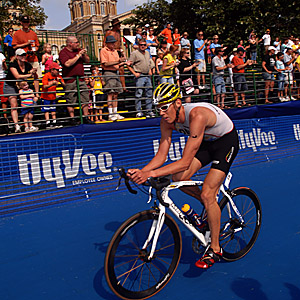
ST: How tough was it to recover?
Rasmus: I had my physio with me and he treated me straight after the race and the morning after. Then we flew back together and had a layover in Beijing, so he gave me another treatment. On Monday and Tuesday it was still pretty bad. But by Wednesday, my muscular situation had improved so that I could walk up and down stairs without holding on to the rail.
ST: How bad was it compared to other long course races you’ve done?
Rasmus: I remember I raced an Ironman distance race at Frederica in 2000 for the Danish long course Championship and in 2001 I raced there for the ITU World Championship. In 2000, I won in 8:38 and Olaf Sabatschus got third. In 2001, (fellow Dane) Peter Sandvang won and I finished second, one minute behind, in 8:25. It was not a fast course.
ST: Looks like you could have had a good Ironman career. Why did you stay with Olympic distance and speed?
Rasmus: Back then, I wanted to do the Olympics. I had been a swimmer many years and the Olympics are the biggest thing in that sport. Also, I really enjoy that type of racing, racing fast and doing a lot of races. I enjoyed the ITU social network, being out there with all the guys several times in a season and I was good at that. I think I would have been really good at Ironman as well. But I was the only Danish guy who could so anything in short distance. In long distance, they still had Sandvang and Torbjorn Sindballe and it was my responsibility to keep the Danish flag out there on the short circuit.
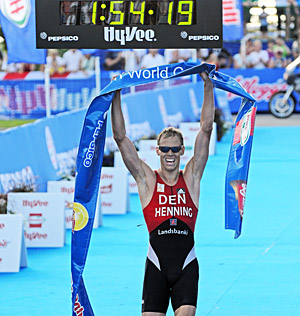
ST: How close was your Ironman plan to working at Hainan?
Rasmus: If I had my special needs halfway on the bike, I am sure things would have been better. But would I have avoided cramps completely? I am not sure.
ST: What were you trying to do on that day? You went out hard with a 40-minute swim, obviously short but still by far the best on the day, a 4:29 bike, and finished the first half of the marathon on pace a world-class, 8:15 Ironman finish.
Rasmus: I tried to race on the swim and the bike and halfway on the run as if it were only 25-30 degrees Celsius. I wanted to test myself to see how my body reacted to the heat. If I had wanted to just make the fastest possible race on the day given the circumstances, I would have slowed down pretty early on the bike and dropped to 120 beats per minute heart rate. So I would have lost not 15 minutes but only 10 of my 45-minute lead off the bike. And if I had started running at 4:30/kilometer pace I could have held it the whole way, instead of going hard and then dropping back and walking.
ST: How well do you adapt to heat – which seems to be a key factor in people who have a chance to win at Kona?
ST: Generally I tolerate heat very well, but in this race I was trying to assess my ability to race hard in the heat and adjust to it. Earlier on in races, for instance at Hy-Vee, I didn’t run flat out from the beginning. I knew in my heart like that I had to save something in the tank for later on. I did not want to push so hard I would cross that line where I could not recover. I needed to stay below that point the whole time. But when I’m in really good shape, I seem to be able to go at a reasonably high level the whole way.
The important thing is I am never overwhelmed by the heat, where you think there is no way you can keep on going. A lot of other people seem to have days like that. Not me.
ST: What did you learn about Ironman that was most important?
Rasmus: In China I learned that nutrition and hydration is extremely important. I was aware of it already, but I learned I might need to pay even more attention. I need to try out different mixes of electrolytes and sugars before Hawaii. I will prepare for Hawaii a lot more than for China as far as heat adaptation. So I will get out there 2 weeks before. In China I got there one week before the race. Before that race I had been training in the Danish winter and early spring, in temperatures below 20 degrees Celsius.
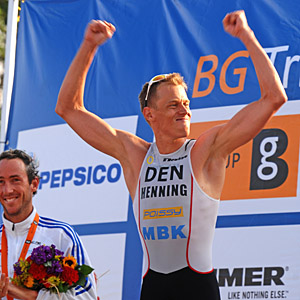
ST: What happened in Beijing when you finished 8th,, 67 seconds back of the gold medal? Two months earlier at Hy-Vee, you dominated a world class, Olympic-level field.
Rasmus: I think the main thing in Beijing is that I was actually going pretty well until three or four weeks before the Olympic race. I was very healthy at Hy-Vee at the end of June (where he won his second straight $200,000 first prize) but at that point I had not even started my real Olympic buildup. The level of training I did at the end of July was very different. I remember having a day where I am pretty sure I could have run a sub-30 minute 10k after a hard bike session. I felt so extremely good I started that run at 3:10 per kilometer and ended up running 2:50 per kilometer.
Then, I went to Korea with my coach Michael Krüger and my physio and fellow Olympic triathletes Dirk Bockel (of Luxembourg) and Marko Albert (of Estonia). From the time I got to Korea, I never got into that really strong feeling again. I don’t know what happened. Travel and jet lag probably set me back a little bit. Still, the training and racing went pretty well. I thought I would have a shot at a medal but in the final few days before the race I got sick. The last few days before the Olympics I spent the whole day in bed and did no training. I did not have a high fever, but I felt pretty lousy. I felt better the next day and the day of the race, but I never got my body feeling optimum. Things probably could have and should have been done differently. But I think it was also a stroke of bad luck.
ST: how did the race go?
Rasmus: I could feel it straightway on the swim that I did not have a day that would take me to the medals.
ST: What caused it? Food? Illness? Jet lag?
Rasmus: I don’t think it was anything I ate. I did eat the hotel food. All the athletes did, too. I was careful not to eat anything from tap water and stuff like that. I did not go to any little local restaurants an eat lunch the day before the race. I think the simple act of travel always puts you in close contact with a lot of other people. And when you sit in the plane the air re-circulates all the germs in the passenger cabin. So there’s always some risk and it’s really bad luck when it happens at a time like that.
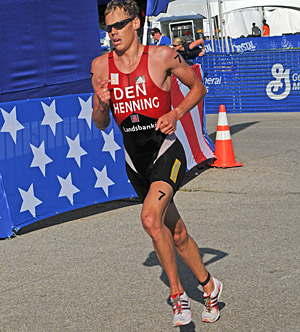
ST: Will you defend your two-straight titles at Hy-Vee? Will you race any ITU World Championship series races such as Washington DC? Why?
Rasmus: I am not sure yet if I will defend at Hy-Vee. I am leaning towards not going. I think for my Hawaii buildup I should take it easy in May and June. If I want to go to Hy-Vee, I do not want to simply finish in the middle of the field. If I could be in the mix, not win necessarily, but maybe have a shot at the podium, I would need to put in some serious effort to June. Maybe for Hawaii I should maintain a low profile. I will need to see how I things are going for the next 3-4 weeks. If I get into a rhythm, and things feel good, I’d love to come back. It would be nice to meet all the athletes and organizers again. I have had a great relationship with the organizers and they have made it a pleasure to come there and I would like to do what I can in return.
ST: Some think you are a competitor who is either on fire or lukewarm — all on or all off. Is this true?
Rasmus: I don't really agree on that. I just think that is the nature of a competitive athlete. I have not had that many off performances really. Throughout a short distance season, I have 2-3 really high performance races, and a bunch that would be in between 4th to 12th. And always there would be one or two where nothing worked out. It is a pretty natural thing. If you knew if you are going to have bad race, or if you did not feel well, you would stay home and those low spots would not be reflected in your statistics. I just learned over a year, I need to do relatively few races to do well and try not to travel so much.
ST: You have had some injuries?
Rasmus: I had a plantar fasciitis which was really tough in 2006. I have also had recurring Achilles problems as well. Actually since the Olympics I have struggled a little with that. It’s been keeping me from running the volume I’d like.
ST: What have you learned about Ironman from your fine countryman Torbjorn Sindballe?
Rasmus: Torbjorn and I actually train a lot together at the national training center in Farum, a suburb about 20 kilometers from Copenhagen. We swim together several times in a week. There is enough difference between us in the swim so we do not swim in the same lane. We often do the same program on the bike and run. Torbjorn is very intelligent and I have learned a lot from him and out coach as well working with Torbjorn all the way through all his testing for heat and acclimatizing and hydration – we did it all together and I have been following that on the sidelines. From that I knew pretty well know what to expect from Hawaii. I have been there many times and heard a lot about it.
ST: Why do you suspect he is mysteriously off form recently?
Rasmus: Over the winter, he started to approach things in a different way. I have not seen him a lot at Farum. He would come in and just swim 2k and get out and do a lot of exercises and be gone again. He very much stuck to himself and did special strength workouts. As with me, he is very specific about doing things right. So I am sure he is gonna prevail and come back.


